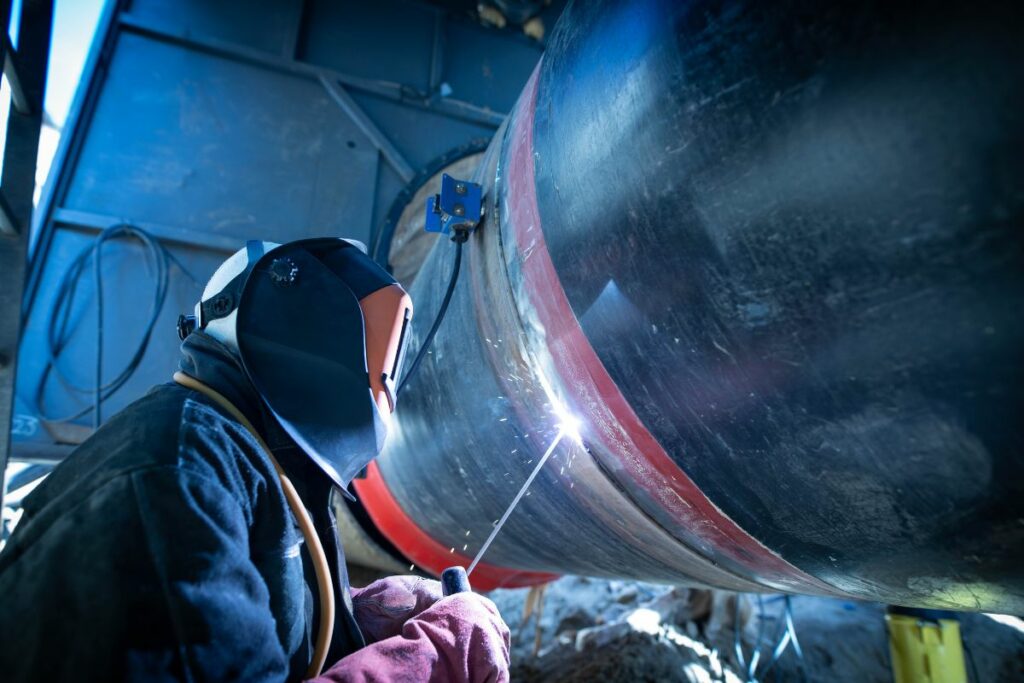
While for many centuries, shipbuilding consisted of shaping wood into seaworthy vessels, nowadays, most ships are constructed with steel to conquer the seas. Shipbuilding is a complex and intricate process that requires precision, durability, and expertise. At the heart of this industry lies welding, a crucial technique that ensures the integrity and safety of marine vessels. Come aboard and join us as we explore the important role of welding in shaping these magnificent vessels that navigate the vast oceans of our planet.
In shipbuilding, welding is essential for creating strong and robust structures that form the backbone of a vessel. Welders use various welding techniques to join steel plates and sections, creating watertight and structurally sound connections. From the hull to the decks, bulkheads, and compartments, welding ensures the vessel’s strength and stability.
The welding process involves the precise application of heat and filler materials to melt and fuse the metal pieces together. Skilled welders meticulously follow established welding procedures, ensuring that the welds meet strict quality standards and comply with industry regulations.
Ships face constant exposure to harsh marine environments, including saltwater, which can lead to corrosion. Welding is critical in protecting ships against corrosion by employing specific techniques and materials. Welders use corrosion-resistant alloys during the welding process to create barriers against the corrosive effects of seawater and atmospheric conditions. Producing clean and properly welded surfaces is necessary to receive special coatings serving as extra protection against corrosion. The quality of the welds and the accuracy of their execution contribute to the overall effectiveness of the corrosion protection measures.
Welders also implement techniques like cathodic protection, where sacrificial anodes are strategically placed on the vessel’s structure to divert corrosion away from welded areas. When the ship is in the water, these sacrificial anodes corrode instead of the critical areas, protecting them from damage. Regular check-ups are done to make sure the sacrificial anodes are working properly and can be replaced when needed. Through careful welding practices, welders safeguard the longevity and durability of the ship’s components, reducing maintenance costs and ensuring the vessel’s overall performance in challenging maritime conditions.
Beyond the structural aspects, welding is instrumental in the installation of various systems within a ship. From piping and plumbing to electrical wiring and HVAC systems, welders play a key role in ensuring the proper integration of these systems. They weld and connect pipes, fittings, and conduits, creating a seamless network that enables essential functions such as water supply, drainage, electrical power distribution, and ventilation.
The precision and expertise of welders are critical in this phase, as any faulty welds or improper connections can lead to system failures, leaks, or malfunctions. Welding in shipbuilding requires a deep understanding of different materials, welding techniques, and industry regulations to ensure the safe and efficient operation of various onboard systems.
The shipbuilding industry continuously evolves, incorporating innovative welding technologies to enhance efficiency, safety, and sustainability. Advanced techniques such as laser welding and friction stir welding are gaining prominence, offering benefits such as reduced distortion, improved weld quality, and enhanced productivity.
Additionally, the use of robotics and automation in shipbuilding welding processes is on the rise. Robotic welding systems are used to handle repetitive and precise welding tasks, increasing accuracy, speed, and consistency. These technological advancements streamline production, reduce human error, and promote worker safety.
Welding stands as the backbone of shipbuilding, guaranteeing structural integrity, corrosion resistance, and seamless integration of vital systems within marine vessels. Skilled welders, armed with their expertise and precision, contribute to the construction of safe, reliable, and seaworthy ships that navigate the world’s oceans. Through advanced techniques, such as laser welding and robotics, the shipbuilding industry continues to innovate, improving efficiency, productivity, and worker safety. Welding’s significance in shipbuilding cannot be overstated, as it plays a pivotal role in shaping the maritime industry, ensuring the durability and performance of vessels that transport goods, facilitate trade, protect countries, and connect continents.